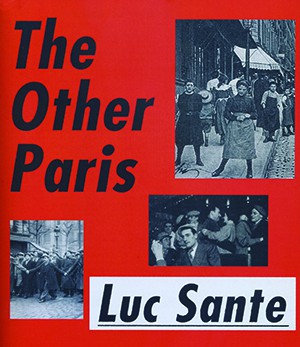You’re about the read what may be the strangest book review you’ve ever come across, because I’m going to admit up front that I haven’t read the book I’m about to review. Actually, now that I think about it, I’m sure that happens all the time—-reviewers on deadline, with an uninteresting assignment, just read a few other reviews, copy, paste, chop, edit and they’re done, without ever having read the book, seen the film, gone to the play, whatever.

That’s not the case here–first of all, I’m telling you I haven’t read the book. That’s the unusual part–not the not reading, the telling you about it. But it’s not because the book is uninteresting–au contraire, mon ami (sorry, I won’t do that again)–I can’t wait to read The Other Paris by Luc Sante. I know it’s going to be as fascinating as Low Life, his classic tome of scurrilous and scrofulous old New York. How do I know it’s so good, if I haven’t read it? Let me tell you a story.
A few weeks ago, I was visiting friends in upstate New York, and I took a trip to Hudson–I wanted to see what all the fuss was about. I poked around for awhile and wandered into the Spotty Dog bookstore. Facing me on the shelf as I walked in was The Other Paris. I picked it up, flipped through a few pages and thought, Yes, I must get this. But not now–I’m traveling and my bags are overstuffed already. I’ll have my wife get it for me for Chrismukah.
As usual, I was hungry so I got some lunch at a nearby café, La Perche, a “French” bistro. I was feeling homesick for France, where I lived for a few years, long ago. Perusing The Other Paris no doubt set off this wave of nostalgia. I did what I always do when I miss Paris, and I’m in some faux Parisian establishment–I ordered a croque madame (a grilled ham and cheese sandwich with a fried egg on top). After my not-too-satisfying repast (croque madames, like so many things in life, are never as good as they sound), I took a look on FB and saw that my friend Ted was at his house in Catskill, just on the other side of the river. I called him to see if he wanted to hang out. “Hey, what’s up?” he said. “I saw you’re up in Catskill. I’m in a cafe in Hudson and wondered if you want to hang.” “I’m in a cafe in Hudson too. Which one are you in?” “La Perche.” “Me too!” I looked up and there he was, with his girlfriend, three tables away. We had a good laugh and drank some coffee. He told me they were going to Woodstock that afternoon to see Luc Sante give a reading from The Other Paris. Now, that’s serendipitous as fuck, I thought.
A few hours later we were at the Golden Notebook, an excellent bookstore in Woodstock. The room was packed. We got the last standing-room -only spots, way in the back. Luc Sante sat up front, looking very dapper. He apologized for his appearance, saying he was on his way to a wedding. (Maybe so, but I had the feeling he is sartorially correct even when lounging at home.) Luc introduced the book, then began reading. The stories were fascinating. I learned why the word for “garbage can” in French is “poubelle,” something my fellow Anglophiles and I had spent hours ruminating over back in the day. We thought it was one of those wacky French inversions, where you say “garbage” by combining the words for stinky (pou) and beauty (belle). Stinky beauty? Turns out, it’s eponymous–the guy who invented the garbage can was Eugène-René Poubelle. At long last, the true meaning of the garbage can!
Luc went on to regale us with the tale of the Theirs Wall, built between 1841 and 1844. Louis-Philippe, King of France, decided that the key to the defense of Paris was an impregnable wall. The wall defined the new city limits; Paris expanded to its current size, a big land grab, swallowing up the village of Montmartre and several other formerly independent towns. The wall was tall; a sloping area outside it, called a glacis, extended outward to the location of today’s Boulevard Périphérique, the disgusting highway that encircles Paris. We heard about how the multitudes of rag pickers who once roamed Paris were systematically driven out of the new-and-improved town. They ended up living just outside the gates of the wall, an area known as “the zone.” They set up little shops, selling their rags and bones; these shops grew larger and larger and survive to this day as La Puce, the world-famous flea market. La Zone is also where the fine, upstanding denizens of Paris went when they wanted to engage in proscribed fun and unsavory activities. Having proved militarily useless at least a couple of times, the wall was torn down in the 1920s. But when I lived in Paris, many decades later, if you ever found yourself in a louche or dicey club or bar or party, the French would mutter, “C’est la zone!” Bizarre, somewhat frightening folk were still called “zonards.” I never knew any of this when I lived in Paris, and it was a joy to discover it.
So I ended up buying a copy after all. I managed to find room in my suitcase and brought it back to California. My wife will gift wrap it and give it to me for Chrismukah. Other family members will be confused by how she got Luc Sante to inscribe it to me. I can’t wait to read it.
The Other Paris, by Luc Sante, Farrar, Straus and Giroux, 320 pages. Reviewed by Bernard Meisler
Reviews